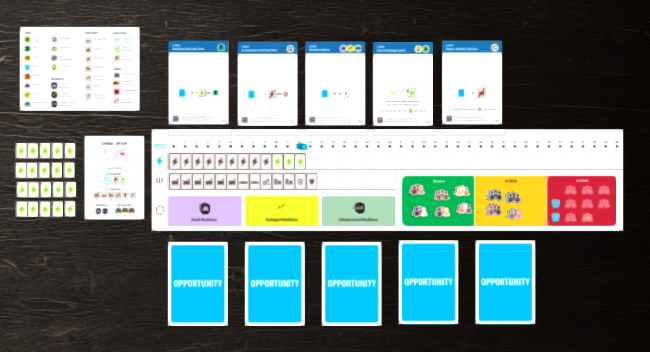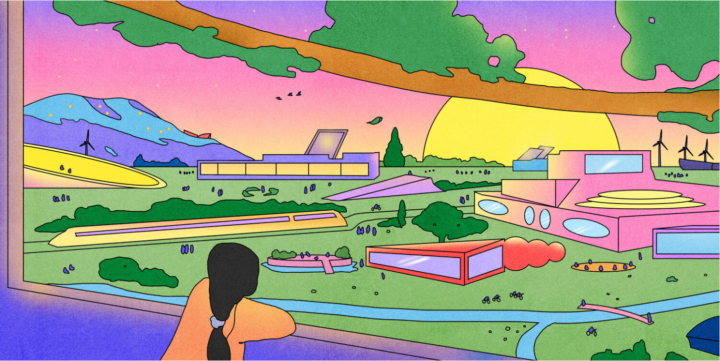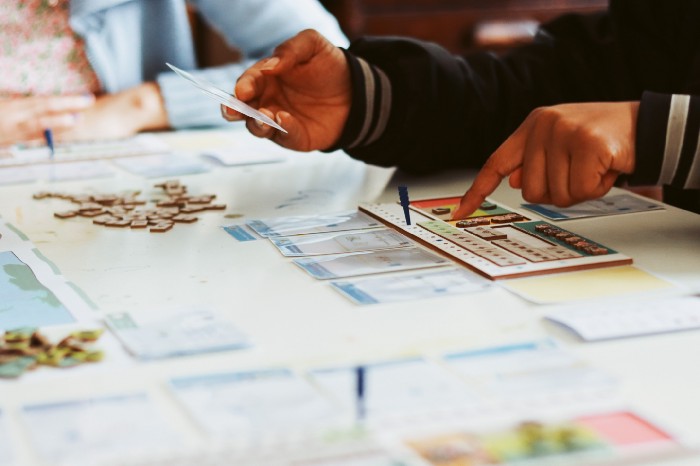At the end of July and beginning of August, the Lessons Learned team (alongside Route 726 collaborator Carolyn Aubry) had the wonderful privilege to play test Daybreak, an upcoming board game about the climate crisis designed by Matt Leacock and Matteo Menapace. This cooperative game will place players into the roles of world leaders, with each person guiding one of the United States, China, Europe, or the Majority World through the global healing process. Although each player will represent their own global power, everyone will need to work together if you hope to cut CO2 emissions, transition to clean energy, and protect vulnerable populations before the climate crisis spirals out of control.
Our play test was led by co-designer Matteo Menapace, who talked us through the game’s origins, aims, and rules. According to the project’s design log, Daybreak started in earnest after Menapace and Leacock each wrote reflections on what Leacock’s hit game Pandemic taught them about the burgeoning COVID-19 pandemic in early 2020. The two designers were brought together online, and discovered that they both were interested in using games to examine the climate crisis. Menapace says,
“We arranged a video-call for Easter Monday. At that point I didn’t know it would be the first of weekly game design meetings.”
Matteo Menapace, Daybreak co-designer, Design Log
From the outside, Menapace and Leacock’s meeting now seems as if it were destined to happen, with Daybreak —the fruit of their collaboration—shaping up to be an exceptional product for gamers and learners alike. The game already feels like a sublime combination of information, inspiration, and pure old fashioned fun! It’s an exciting and entertaining experience, but it doesn’t minimize the urgency or importance of the subject matter. The designers have laid the groundwork for some incredibly satisfying cooperative gameplay, difficult decision-making, and clever mechanics. Will you spend your limited resources researching solar energy or building nuclear power plants? Will you try to mitigate the ever-rising heat by releasing clouds of atmospheric sulphur or will you fund a global reforestation project to sink more carbon? Whichever projects you end up choosing, the choices feel important and impactful, each altering the rest of the game for yourself and your fellow players.
It is always a humbling learning experience when we get to experience the work of other designers. One of Daybreak’s core design choices (which Menapace outlines here) is the presupposition that “the leaders of the world have already been pressured to take the climate crisis seriously,” and that these world leaders are committed to working together to solve the issue. Most LLST designs (including The Day My Life Froze, Missed Connections, and Humanitarian Perspectives) aim to highlight and examine how differing perspectives can lead to a breakdown in communication between various stakeholders, even when those stakeholders ostensibly hold the same goal. By contrast, Daybreak does away with these built-in conflicts, and instead delivers an experience that is wildly different than anything LLST might have created. The resulting experience is effective, clever, and elegant. In fact, I found Daybreak to be all the more compelling because of this cooperative approach: the design shows us a challenging and harrowing path towards carbon neutrality, but also an idealistic and hopeful one. Menapace writes, in regards to full cooperation:
“It is a big assumption to make, but not an unreasonable one: what seems politically unthinkable today might become common sense in a few years and we aim for this game to play a role in accelerating this shift. If the game, in its simplified model of the real world, can offer people alternative visions of what tackling the problem might involve, then we can spark informed conversations and help people choose leaders who will take action.”
Matteo Menapace, Daybreak co-designer, Design Log
Overall, our Daybreak play test was an educational, inspiring, and enjoyable experience, which highlighted the power of games to provoke positive change. We would like to thank the entire Daybreak team for the opportunity to play test their work. Especially, we would like to thank Matteo Menapace for guiding us along the journey and joining us in both of our virtual sessions, hosted on Tabletopia. If you want to read more about Daybreak check out the official website where you can also find the link to their design log and sign up for a notification email when the game is launched.

Daybreak is published by CMYK and designed by Matt Leacock and Matteo Menapace. Daybreak illustration by María Medem.



